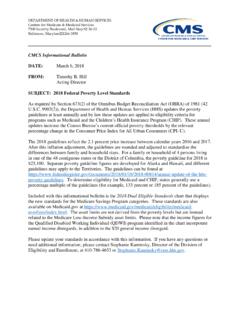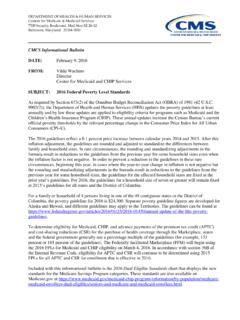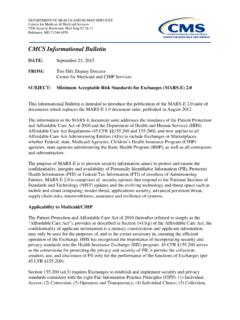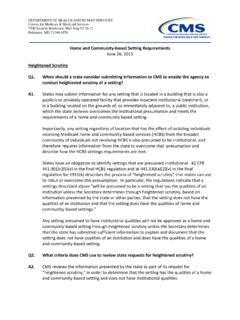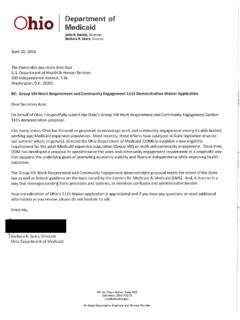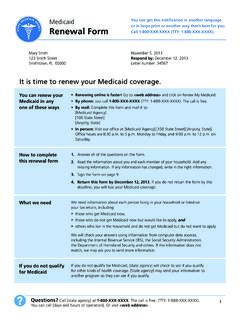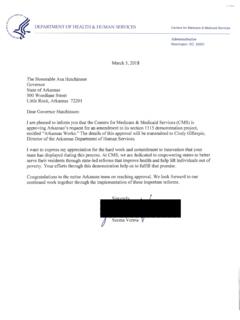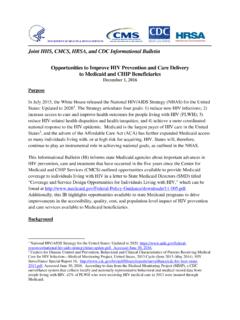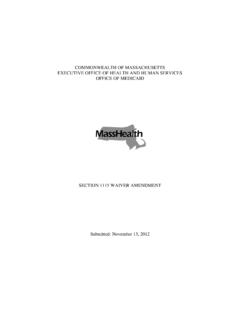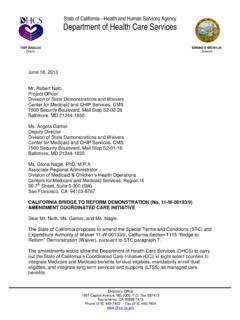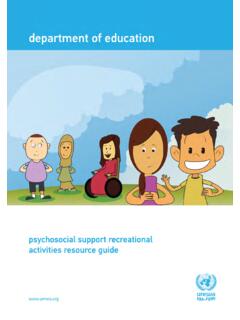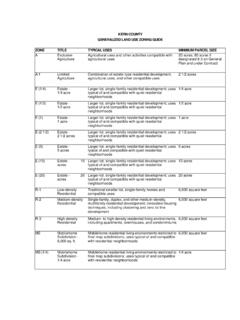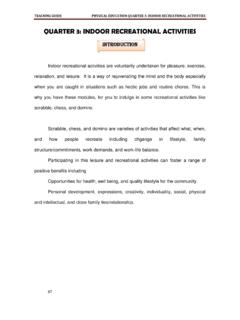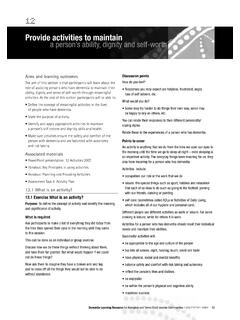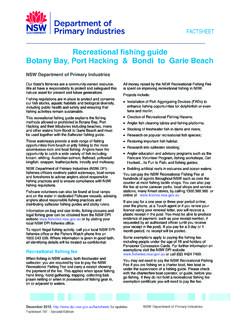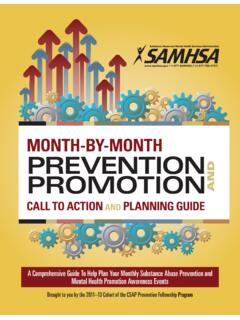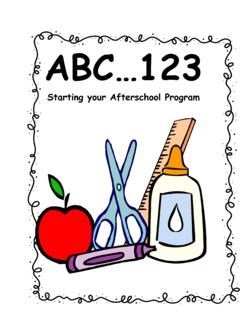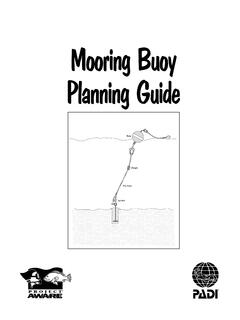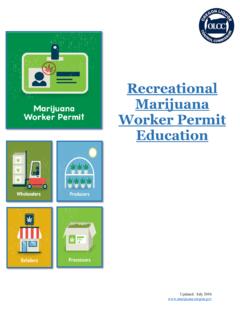Transcription of ASAM Resource Guide - Medicaid
1 Overview of Substance Use Disorder (SUD) Care Clinical Guidelines: A Resource for States Developing SUD Delivery System Reforms April 2017 For the past two years, the Medicaid Innovation Accelerator Program (IAP) has been providing a broad group of state Medicaid and behavioral health agencies with a variety of technical support resources to support the development of robust approaches for addressing substance use disorders (SUD). In addition, IAP has also been working directly with a small group of leader states on issues related to reducing substance use disorders, as well as with a number of states to assist with their planning and development of section 1115 demonstration proposals focusing on Through our close work with states under various IAP SUD activities , we have developed tools and resources such as this one designed to support state efforts to introduce policy, program and payment reforms appropriate for a robust SUD delivery system.
2 The purpose of this Resource is to support states in their ongoing efforts to introduce SUD service coverage and delivery system reforms by providing information about the preventive, treatment and recovery services and the levels of care comprising the continuum of SUD care. This document also provides an overview of nationally developed guidelines for SUD treatment criteria, including provider and service standards for each level of care. In addition, it provides useful tools and examples of state-based initiatives that can assist states in their efforts to ensure that care is delivered consistent with industry standard SUD treatment guidelines and that Medicaid beneficiaries receive the most appropriate services given their treatment and recovery needs.
3 1 Medicaid Innovation Accelerator Program Reducing Substance Use Disorders. High Intensity Learning Collaborative fact sheet . 2 SUD TREATMENT CARE CONTINUUM AND PROGRAM STANDARDS Needs assessments and other research have shown that not all state Medicaid programs offer the full continuum of services needed by individuals with a 3 The SUD continuum of services should include interventions that are capable of meeting the various types of individual s needs, including various levels of care. As individuals move throughout the continuum in their recovery from SUD, they may need to transition to levels of care of greater or lesser intensity, depending on their clinical needs. An example of patient flow throughout the SUD care continuum can illustrate how important service coverage of the full range of care is to appropriately treating SUD.
4 An individual with SUD may be admitted to a medically managed withdrawal management or inpatient facility with acute physical health care needs requiring medical and nursing care. Once medically stable, the individual may next need a clinically managed adult residential program for treatment services or an intensive outpatient or outpatient program that includes medication assisted treatment (MAT). Alternatively, an individual with SUD may begin treatment by receiving outpatient treatment services only to find that a more intensive level of care, such as intensive outpatient treatment, is more appropriate. Without the ability to transition to less or more intensive levels of care throughout treatment in response to changing clinical needs and treatment goals, individuals with SUD face higher risk of relapse and worse behavioral and physical health outcomes, including increased inpatient hospital 5 Through our work with states, we have found that comparing existing Medicaid SUD benefits side- by-side with the nationally developed SUD care continuum is a useful exercise for identifying how well service coverage aligns to the full continuum of SUD services.
5 This will allow states to identify any gaps in their coverage and review their inventory of SUD providers that offer these services. Included in this document is a template that can be used to crosswalk state Medicaid coverage of SUD services with the continuum of care described in the American Society of Addiction Medicine (ASAM) Criteria (see Appendix One). In addition to aligning benefits coverage with nationally accepted guidelines, states can also assess their program standards to ensure that SUD service provision adheres to the industry standards. Specifically, states can review their licensure standards, regulations, policy, provider manuals and contracts, managed care contracts, or other program guidance to determine if requirements for SUD providers and services comport with important provider and service standards in the ASAM Criteria.
6 This document provides a brief overview of these provider competencies, and includes optional resources that states can use to conduct such reviews (see Appendix Two). These two core features offering service coverage for the full continuum of care and aligning 2 Clark RE, Samnaliev M, McGovern MP. Treatment for co-occurring mental and substance use disorders in five state Medicaid Programs. Pediatr Serv. 2007;58(7):942 948. 3 Garnick DW, Lee MT, Horgan CM, et al. Adapting Washington Circle performance measures for public sector substance abuse treatment systems. J Subst Abuse Treat. 2009;36(3):265 277. 4 Magura S, Staines G, Kosanke N, et al. Predictive validity of the ASAM Patient Placement Criteria for naturalistically matched vs.
7 Mismatched alcoholism patients. Am J ;12(5):386 397. 5 Sharon E, Krebs C, Turner W, et al. Predictive validity of the ASAM Patient Placement Criteria for hospital utilization. J Addict Dis. 2003;22 Suppl 1:79 93. 3 provider requirements consistent with industry standards are some of the hallmarks of a transformed system of care for individuals with SUD. ASAM CRITERIA The ASAM Criteria: Treatment Criteria for Addictive Substance-Related, and Co-Occurring Condition 6 (henceforth called the ASAM Criteria) contains the most recent set of industry guidelines released on the treatment of SUDs. This Resource provides a brief overview of the key provider competencies described in the ASAM Criteria. The Medicaid IAP appreciates the informal review, edits and contributions provided by ASAM to the clinical summaries included below.
8 The content included in this document is an abbreviation of the full principles, concepts, and process described within the ASAM Criteria. Furthermore, the summary information in this document is based on the latest science available at the time of its release (the third edition of the ASAM Criteria) and will need to be updated upon subsequent editions and the availability of new research and science. The ASAM Criteria describes five broad levels of care (Levels 4) with specific service and recommended provider requirements to meet those needs. These levels of care (Levels 4) span a continuum of care that represent various levels of care. A full list of the levels of care is provided in Figure 1, with more in-depth descriptions following this 6 Mee-Lee D, ed.
9 The ASAM Criteria: Treatment Criteria for Addictive Substance-Related, and Co-Occurring Conditions. Chevy Chase, MD: American Society of Addiction Medicine; 2013. practice/guidelines-and-consensus-docume nts/the-asam-criteria/text. Accessed March 18, 2016. 7 The ASAM Criteria discuss their application to adolescents in some detail, although they are not specified completely for adolescents as a separate population. The book includes a matrix for matching adolescent severity and level of function with type and intensity of service. 4 Figure 1. ASAM Levels of Care 5 Definition of Treatment Terms Throughout the ASAM Criteria, the following treatment terms are used to describe services within a specified level of care: Clinically managed services are directed by nonphysician addiction specialists rather than medical personnel.
10 They are appropriate for individuals whose primary problems involve emotional, behavioral, cognitive, readiness to change, relapse, or recovery environment concerns. Intoxication, withdrawal, and biomedical concerns, if present, are safely manageable in a clinically managed service. This type of care is described under Level , and residential programs. Medically monitored services are provided by an interdisciplinary staff of nurses, counselors, social workers, addiction specialists, or other health and technical personnel under the direction of a licensed physician. Medical monitoring is provided through an appropriate mix of direct patient contact, review of records, team meetings, 24-hour coverage by a physician, 24-hour nursing and a quality assurance program.
